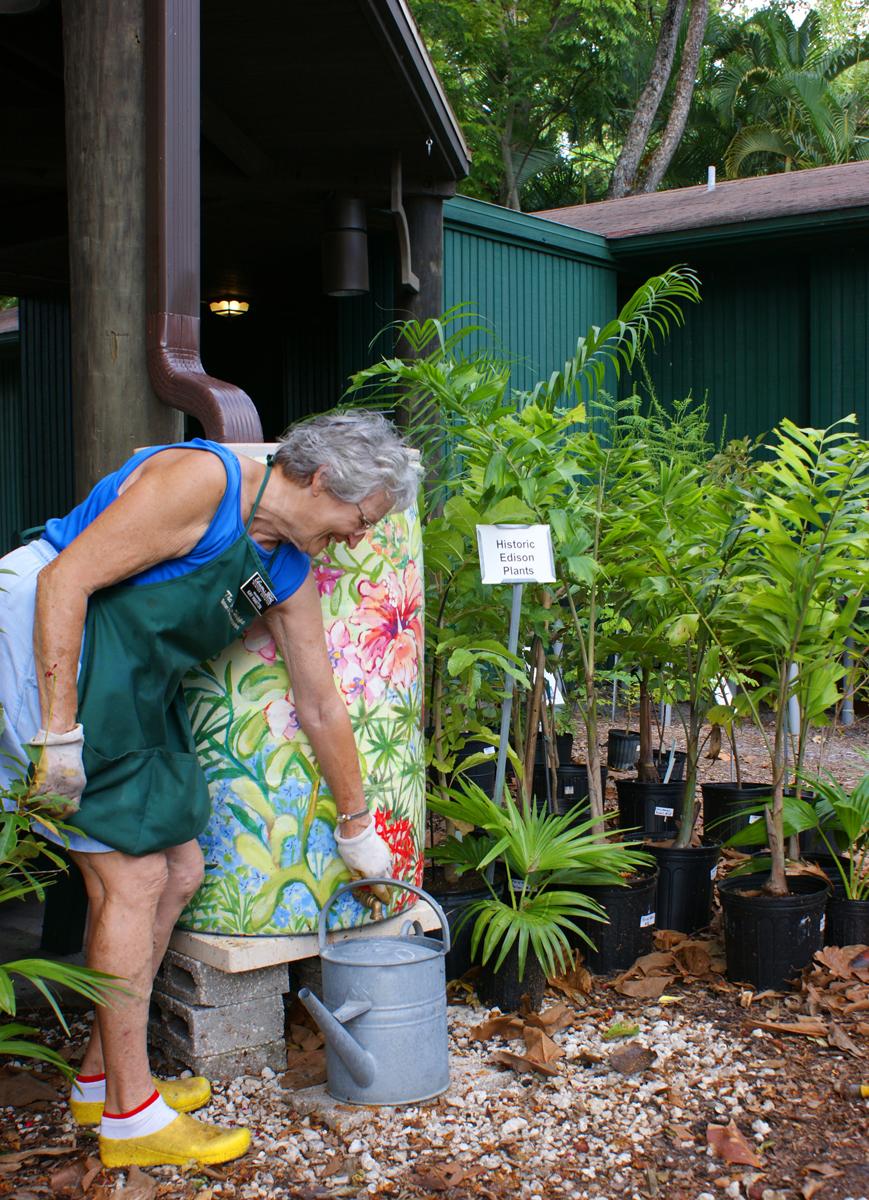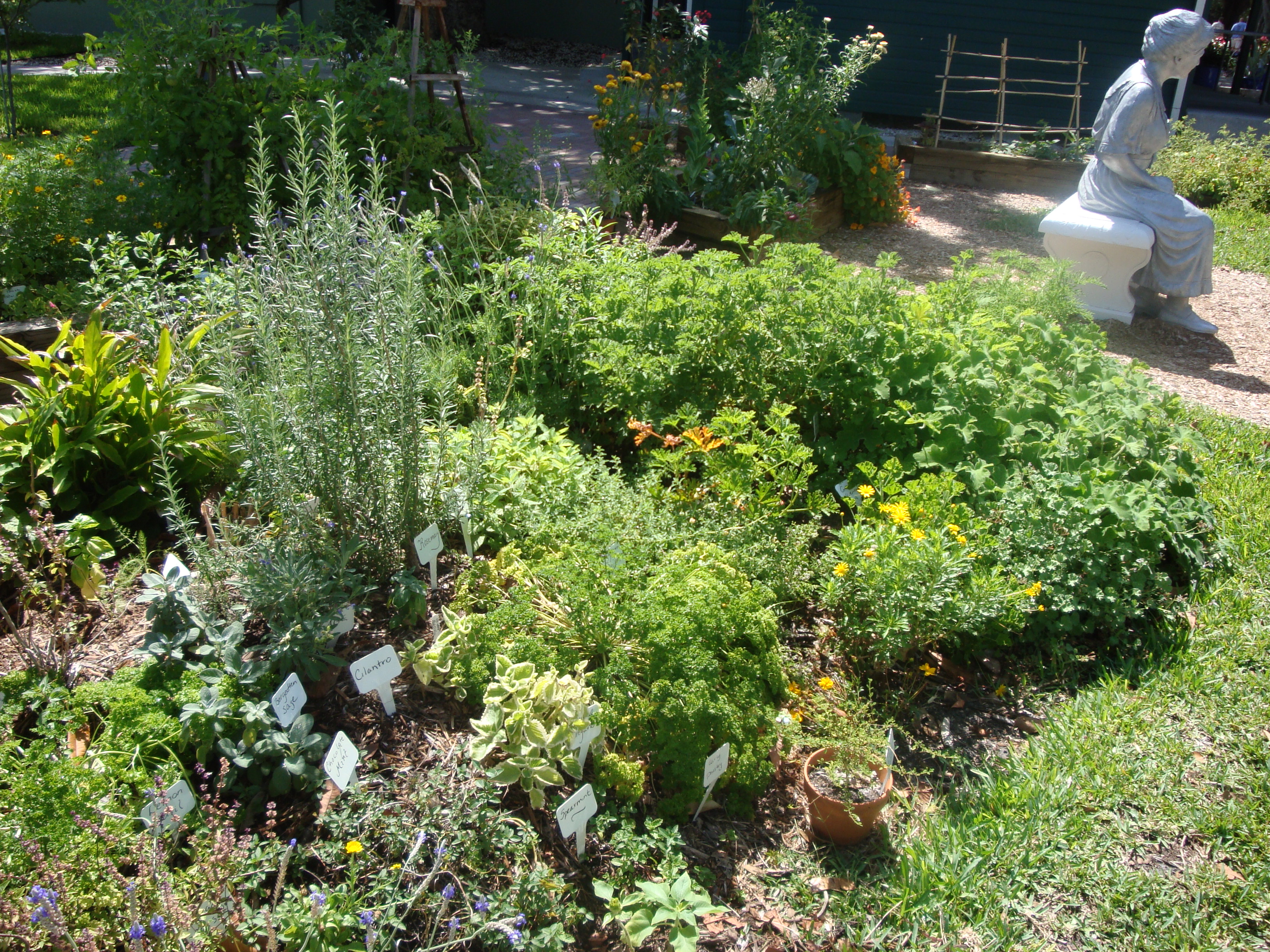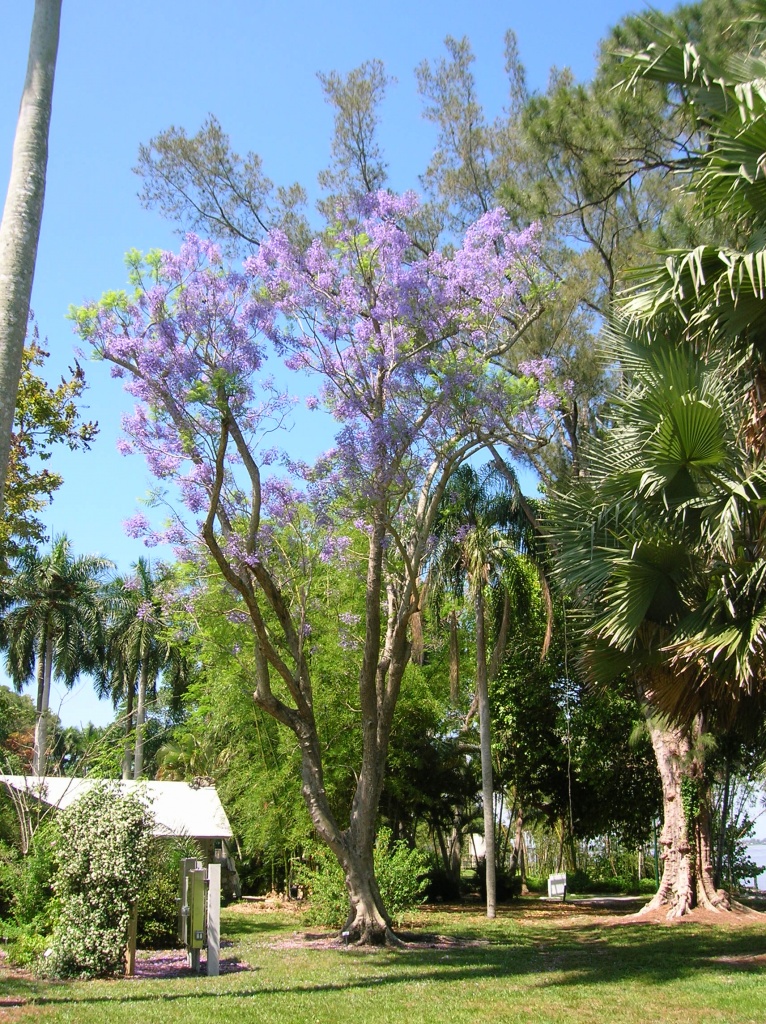Rain Barrels Conserve Water During A Dry July
by Debbie Hughes, Estates Horticulturist
It’s summer in Florida and rain doesn’t seem to be on the menu for the month of July. One way the Edison and Ford Winter Estates is coping with the dry weather is by using rain barrels. With the help of the Florida Yards and Neighborhood Program, we installed a recycled 55 gallon rain barrel painted by a local artist, Marie Dyer. Since the rain hasn’t been exactly coming down in torrents, the rain barrel has become a handy addition in the gardens. Rain barrels are great for watering pots or containers since they dry out easier during the summer months with the higher temperatures. All of our potted plants are watered by this collection system.

How we did it:
- We cleaned the recycled barrel (in it’s previous life it contained hair conditioner), then drilled holes in the upper right and left sides to allow for rain water overflow using ¾” PVC elbows. When we get a steady downpour in Southwest Florida there is more than 55 gallons of water running off the roof making overflow necessary.
- The spigot to retrieve the stored water is installed 6” above the bottom of the barrel. It is best to place the rain barrel on a platform consisting of stepping stones on top of cement blocks. The elevation allows a watering can to be placed under the spigot.
- Our installation connected the gutter system into the barrel, but if your home does not have a guttering system, be creative. Find an area where water pours off a roofline, cut a bigger hole in the top, then fit a screen over the opening to seal out debris.
Other ideas include:
- If you are concerned about mosquito breeding inside the barrels, put 2 teaspoons of vegetable oil to coat the surface periodically.
- The higher you mount the barrel off the ground the greater the pressure of the water coming out of the spigot.
- You can install a drip or soaker hose on the end of the spigot to direct water overflow to a vegetable garden nearby, Install the rain barrel near the area it can best be put to use.
- Use rain water to clean garden tools.
- Paint your rain barrel the color of your home to blend into the landscape.
- Check with your community rules, and if there are rules against such features, go to your homeowners association committee meetings to promote the use of these water saving devices.
Look for our next rain barrel workshop at the Estates or just stroll into the Garden Shoppe to see them first hand being used.
If making your own barrel is not at the top of your list of things to do this summer, the Estates Garden Shoppe sells painted and plain rain barrels ready to go into your garden.
For more questions call the Estates Garden Department at (239)334-7419 or leave a comment.
The Edible Garden
by Debbie Hughes, Estates Horticulturist
The Estates has many edible plants this time of year, such as curcuma (turmeric), shampoo ginger, galangal, lemongrass, allspice, okra, eggplant, roselle, and pepper seedlings. When the season cools down, the palette will change into more traditional herbs such as basil, oregano, thyme, chives, rosemary, mints etc.
Once a gardener has made the decision to use a little piece of land to grow something useful, the fun begins. Getting started is the hardest part, but don’t be dismayed. Thomas Edison once said, “Genius is 1% inspiration and 99% perspiration;” nowhere is this more evident than in the garden. Consider starting an edible garden near your door for easy access in maintenance and utilization. Besides, when you brush past the herbs, you can’t help becoming inspired by their enticing aroma.
There are some easy techniques one can employ to make growing your own herbs easier and become a genius in the kitchen. One technique I have found successful for growing herbs is the mound or lasagna method.
A “No Till Garden” consists of:
- layer of newspaper
- layer of compost
- layer of potting mix
- layer of worm castings
- last layer of food approved mulch

The hill can vary from 18” to 24” in height, allowing for planting room on the sides and top. Mounds, raised beds, or container gardens allow less bending over, easing your back and knees. Containers allow freedom to move the herbs where they may be the happiest depending on sun and water conditions. Place the herbs near a hose or a rain barrel for easy watering.
If you would like to see an example of this type of garden, there is a demonstration for public view in the Estates’ Heritage Garden next to our newly dedicated Mina Edison Statue. Come to the Garden Shoppe at the Edison and Ford Winter Estates during the week. Our hours are 9-5 every day. Estates Members receive a 10% discount on all Garden Shoppe merchandise.
Choosing the Right Tree
by Debbie Hughes, Estates Horticulturist
Everyone needs a tree in their yard to provide some shade, and our summer rainy season is a perfect time for planting. I am going to tell you a little secret to help you decide on what tree to choose. The most important mantra you should repeat to yourself is “Right plant in the right place.” If you want to be happy with your choice for the lifetime of the tree, do the research.
- Determine the mature height and spread, the flower, fruit, or leaf drop, and the wet, cold and salt tolerance.
- Size matters – especially if you don’t want the tree to take over your property (or your neighbors).
- A tree with flowers that fall on your driveway and car can be messy, but perfectly acceptable over the middle of the grass.
- Most tropical fruit trees won’t survive in cold winter temperatures in northern regions of the county.
- If you only live in Florida in the winter months and want a fruiting or flowering tree, make sure it blooms while you are in town.

jacaranda tree
Most people buy plants and then decide where it should go in the landscape. This is a no-no. You will end up with the wrong tree for your situation and have to spend the money to cut it down later; not to mention losing all those years of growth only to be back where you started.
Some great choices for trees include (but there are many more):
- SMALL: East Palatka Holly, Crape Myrtle, Orange Geiger, Bahama Strongbark, Sweet Acacia, Senna Surattensis, Tabernaemontana Orientalis (blooms smell like buttered popcorn)
- MEDIUM: Foxtail Palm, Shady Lady Black Olive, Tabebuia (Golden Trumpet and Caribbean Queen)
- LARGE: Live Oak, Royal Poinciana, Jacaranda, Mahogany, Royal Palm
As the Edison and Ford Winter Estates restores the botanical gardens of the historical property, we invite you to commemorate your marriage, celebrate the birth of a child, or honor a passed away loved one by planting a tree in the gardens or sponsoring a memory bench. For more information on donating a Celebration Tree to the Edison and Ford Winter Estates, please visit https://www.edisonfordwinterestates.org/events/celebration-tree-plantings.